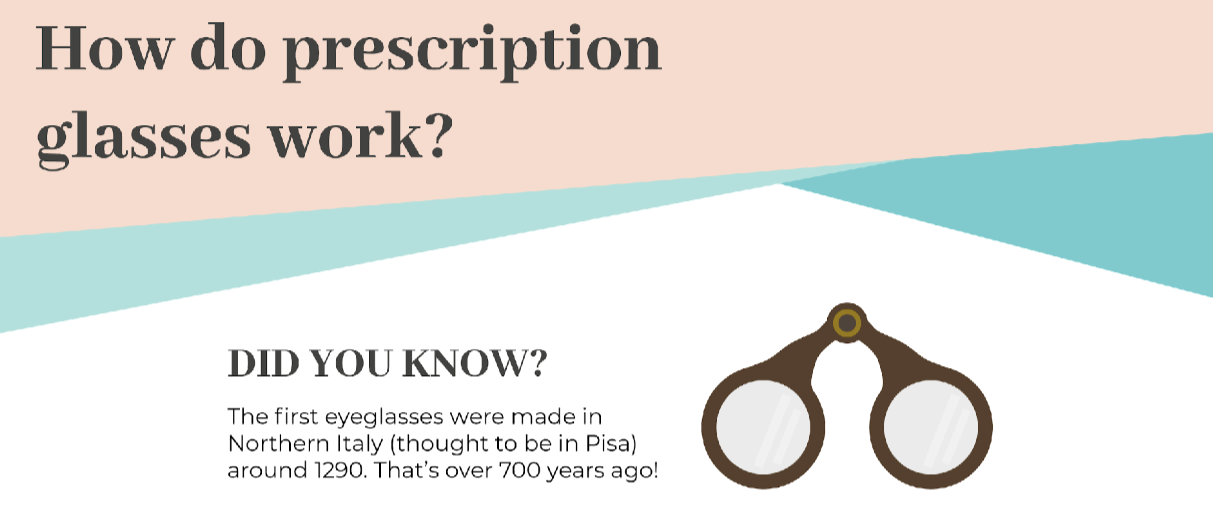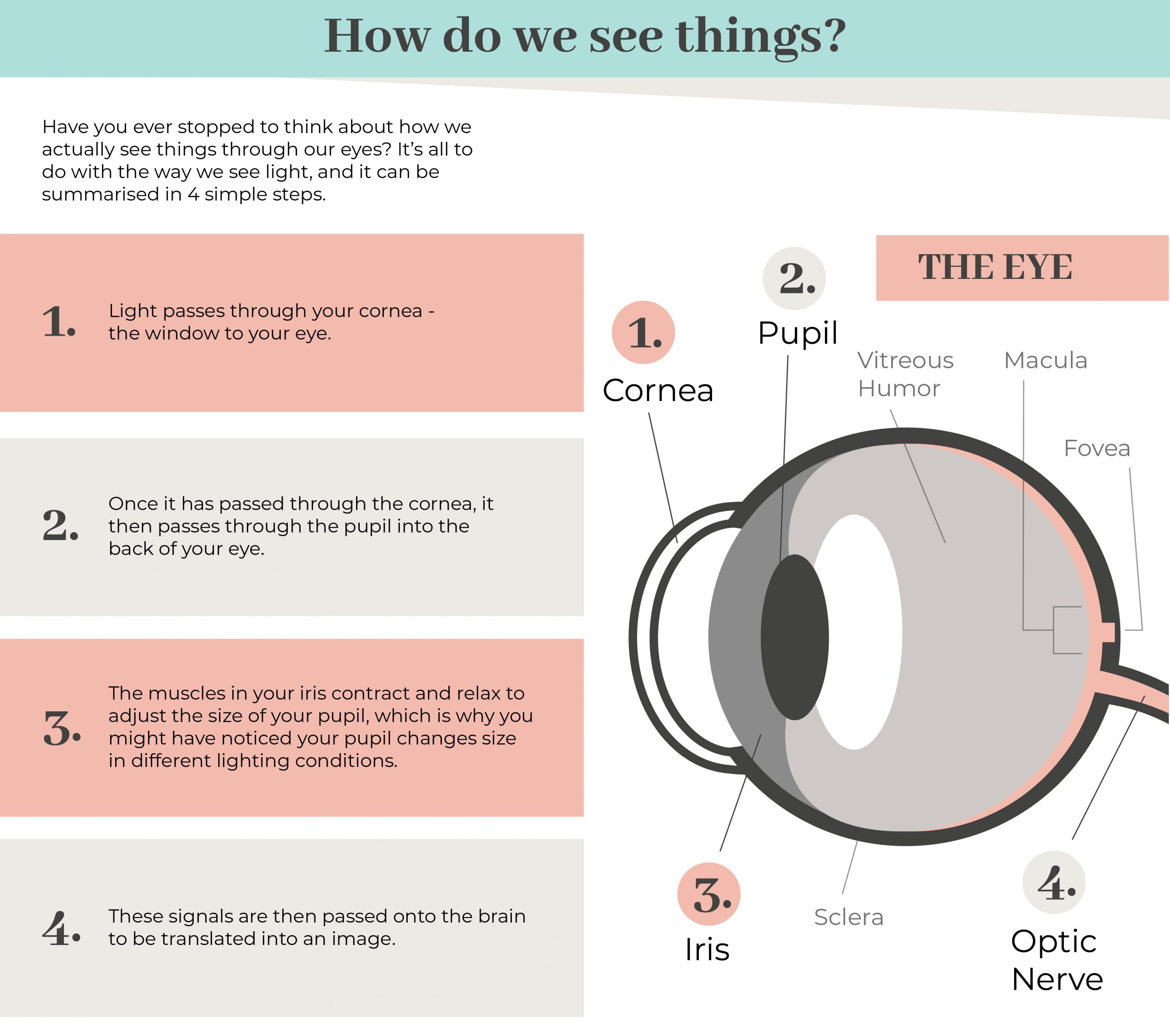
Ever since glasses were invented over 700 years ago, there have been so many discoveries and advancements that have contributed to our general understanding of vision. Better yet, when it comes to buying prescription glasses online, there are now so many options out there. For example, Arlo Wolf’s try before you buy glasses service lets you try up to 4 free pairs of glasses (or sunglasses) before committing to that perfect pair.
Fashion choices and aesthetics aside, what do we actually know about sight and how the glasses of today work? This guide uncovers all:
How do we see things?


Before we go into an in-depth explanation of how glasses work, we must, first of all, explore the science behind how we see things. This science can be explained in four simple steps:
- Light passes through your cornea – the window of your eye.
- Once the light has gone through the cornea, it then passes through the pupil into the back of your eye.
- The muscles in your iris then contract and relax to adjust the size of your pupil. This is why you might have noticed your pupil changes size in different lighting conditions.
- Finally, these signals are then passed onto the brain to be translated into an image.
Considering how much we see in our day-to-day lives, it’s just amazing to think that our eyes continually go through such a process. Now, you may be thinking about how this process differs for those with vision problems. This is where this next section comes in.
Common vision problems
Visual impairment is certainly a common medical phenomenon, with almost 2 million people in the UK living with a certain type of sight loss. Here we look at the three most common vision problems that are out there, why they occur, and what symptoms to look out for:
Myopia (short-sightedness)
Short-sightedness, also known as myopia, is a type of vision condition in which distant objects appear blurry to you. When you suffer from short-sightedness, this means that the shape of your eye causes light rays to refract incorrectly. This, in turn, leads to light getting focused in front of your retina instead of on it.
As well as getting blurry vision when looking at faraway objects, other symptoms of short-sightedness include excessive squinting and enduring headaches that are caused by eyestrain.
Hyperopia (long-sightedness)
The complete opposite to myopia, hyperopia (long-sightedness) is a condition in which close up objects appear blurry to the naked eye. Hyperopia occurs as a result of light not focusing before it reaches your retina. As well as struggling to focus nearby objects, a person suffering from hyperopia may also suffer from headaches and eyestrain.
Astigmatism
Along with myopia and hyperopia, astigmatism is another common vision to look out for. Astigmatism is triggered by an incorrectly shaped cornea, which causes light to focus at more than one place in the eye. Your optician may tell you that your eye is shaped more like a rugby ball instead of a football and this is what’s causing your vision trouble. Astigmatism canoccur with myopia and hyperopia.
Like myopia and hyperopia, common symptoms of astigmatism include headaches, fatigue, squinting, and eye pain.
Lenses and prescriptions explained


Before you purchase those frames, you may want to hold your horses and get to know all about the type of lenses that are going to be used in your future pair of prescription glasses. The science behind this is pretty cool – so read on!
When it comes to the lenses that are used in prescription glasses, there are two main types:
Convex/Plus lenses
A convex lens is used to correct long-sightedness by bending the light towards the bottom and the top of the lens. In other words, any rays of light that make their way through this type of lens are brought closer together.
Concave/Minus lenses
Unlike a convex lens, a concave lens is used to correct short-sightedness by bending the light away from the centre of the lens to a corrected focal point. In other words, any rays of light that make their way through this type of lens are spread out.
Reading your prescription

Before treating yourself to those pair of frames, another key thing that you’ll certainly want to get your head around is your prescription. After all, you may look at your first-ever prescription and just think ‘what does all of this mean?!’ Well, let’s break down the key terms that you may find on it:
Lens strength
The strength of your lens is dependent on how much light has been bent and the level of correction that is required to make your sight better.
OD and OS
Don’t be confused if you see the terms ‘OD’ and ‘OS’ on your prescription. ‘OD’ simply indicates your right eye, and ‘OS’ indicates your left eye!
Cylinder
The cylinder refers to the amount of lens power needed to correct astigmatism. This term would only pop up on your prescription if you suffer from astigmatism.
Axis
This is another term related to astigmatism. The axis refers to the direction that your lens will point to correct your astigmatism. This will be presented in a figure ranging from 1 to 180.
Add
Add simply stands for ‘addition’. The ‘add’ figure is used in prescriptions for bifocal glasses, reading glasses or varifocal glasses, and stands for any additional correction that is needed.
Prism
A prism may correct delicate eye conditions that need the image in focus to change its position. For example, sufferers of double vision may find a prism in their prescription. It is the job of a prism to bend the light without altering focus or distorting vision.
Finding the right pair of prescription glasses for you
And there you have it – the magic behind your prescription glasses! Vision problems themselves can be easily corrected with a pair of prescription glasses or contacts. As mentioned, if choice is what you’re after, be sure to check out Arlo Wolf’s try before you buy glasses. With this exclusive service, you can choose up to 4 pairs of glasses (or sunglasses) to be sent straight to your door for you to try on for style. Also, the best thing about this service is that it’s completely free!

